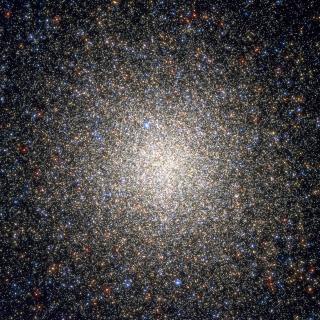Bibcode
Gratton, R. G.; Lucatello, S.; Sollima, A.; Carretta, E.; Bragaglia, A.; Momany, Y.; D'Orazi, V.; Cassisi, S.; Salaris, M.
Referencia bibliográfica
Astronomy and Astrophysics, Volume 563, id.A13, 18 pp.
Fecha de publicación:
3
2014
Revista
Número de citas
28
Número de citas referidas
27
Descripción
We obtained high-resolution spectra for 94 candidate stars belonging to
the HB of M 22 with FLAMES. Previous works have indicated that this
cluster has split subgiant (SGB) and red giant branches (RGB) and hosts
two different stellar populations, differing in overall metal abundance
and both exhibiting a Na-O anti-correlation. The HB stars we observed
span a restricted temperature range (7800 < Teff < 11
000 K), where about 60% of the HB stars of M 22 are. Within our sample,
we can distinguish three groups of stars segregated (though contiguous)
in colours: Group 1 (49 stars) is metal-poor, N-normal, Na-poor, and
O-rich: our abundances for this (cooler) group match those determined
for the primordial group of RGB stars (a third of the total) from
previous studies very well. Group 2 (23 stars) is still metal-poor, but
it is N- and Na-rich, though only very mildly depleted in O. We can
identify this intermediate group as the progeny of the metal-poor RGB
stars that occupy an intermediate location along the Na-O
anti-correlation and include about 10% of the RGB stars. The third group
(20 stars) is metal-rich, Na-rich, and O-rich. This hotter group most
likely corresponds to the most O-rich component of the previously found
metal-rich RGB population (a quarter of the total). We did not observe
any severely O-depleted stars and we think that the progeny of these
stars falls on the hotter part of the HB. Furthermore, we found that the
metal-rich population is also over-abundant in Sr, in agreement with
results for corresponding RGB and SGB stars. However, we do not find any
significant variation in the ratio between the sum of N and O abundances
to Fe. We do not have C abundances for our stars. There is some evidence
of an enhancement of He content for Groups 2 and 3 stars (Y = 0.338
± 0.014 ± 0.05); the error bar due to systematics is
large, but a consistent analysis of data for several GCs confirms that
stars in these groups within M 22 are probably overabundant in He. We
conclude that on the whole, our results agree with the proposition that
chemical composition drives the location of stars along the HB of a GC.
Furthermore, we found a number of fast rotators. They are concentrated
in a restricted temperature range along the HB of M 22. Fast rotating
stars might be slightly less massive and bluer than slowly rotating
ones, but other interpretations are possible.
Based on observations collected at ESO telescopes under programmes
087.D-0230 and 091.D-0151.Tables 3-6 are only available at the CDS via
anonymous ftp to http://cdsarc.u-strasbg.fr
(ftp://130.79.128.5) or via http://cdsarc.u-strasbg.fr/viz-bin/qcat?J/A+A/563/A13
Proyectos relacionados

Vía Láctea y galaxias cercanas
El objetivo general del Proyecto es el estudio de la estructura, historia evolutiva y proceso de formación de galaxias a través de sus poblaciones estelares resueltas, tanto a partir de fotometría como espectroscopia. El proyecto puede dividirse en cuatro líneas principales: I. Historia de formación estelar en el Grupo Local. El objetivo de esta
Martín
López Corredoira